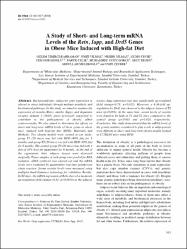| dc.contributor.author | Tımırcı Kahraman, Özlem | |
| dc.contributor.author | Yılmaz, Ümit | |
| dc.contributor.author | Yılmaz, Nesibe | |
| dc.contributor.author | Çevik, Aydın | |
| dc.contributor.author | Horozoğlu, Cem | |
| dc.contributor.author | Çelik, Faruk | |
| dc.contributor.author | Gökçe, Muhammed Oğuz | |
| dc.contributor.author | Ergen, Arzu | |
| dc.contributor.author | Melekoğlu, Abdullah | |
| dc.contributor.author | Zeybek, Ümit | |
| dc.date.accessioned | 2024-03-19T22:28:36Z | |
| dc.date.available | 2024-03-19T22:28:36Z | |
| dc.date.issued | 2018 | en_US |
| dc.identifier.issn | 0258-851X | |
| dc.identifier.issn | 1791-7549 | |
| dc.identifier.uri | https://hdl.handle.net/11363/7230 | |
| dc.description.abstract | Background/Aim: Adipocyte gene expression is
altered in obese individuals through multiple metabolic and
biochemical pathways. In this study, we aimed to examine the
expression of resistin (Retn), amylin (Iapp), and dopamine
receptor domain 5 (Drd5) genes previously suggested to
contribute to the pathogenesis of obesity, albeit
controversially. We also aimed to determine the effects on
short and long-term mRNA levels of these genes in obese
mice, induced with high-fat diet (HFD). Materials and
Methods: Two obesity models were created in our study:
group T1 (20 mice) was fed with HFD (60% fat) for 3
months, and group T2 (20 mice) was fed with HFD (60% fat)
for 6 months. The control group T0 (20 mice) was fed with a
diet of 10% kcal fat supplement for 6 months. At the end of
the experiment, their adipose tissues were dissected
surgically. Tissue samples of each group were pooled for RNA
isolation, cDNA synthesis was carried out and the mRNA
levels were examined by quantitative real-time polymerase
chain reaction. Serum resistin levels were measured using
multiplex bead (luminex) technology for validation. Results:
In T2 mice, the mRNA expression of Retn showed a moderate
up-regulation (fold change=8.32; p=0.0019) in the adipose
tissues. Iapp expression was also significantly up-regulated
(fold change=9.78; p=0.012). Moreover, a 6.36-fold upregulation for Drd5 was observed in the adipose tissues of T2
mice (p<0.001). At the same time, serum levels of resistin
were found to be high in T1 and T2 mice compared to the
control group (p<0.001 and p=0.024, respectively).
Conclusion: Our study demonstrated that the mRNA levels of
the genetic markers considered to play a role in adipogenesis
were different in short- and long-term obesity models formed
in C57BL/6J mice using HFD. | en_US |
| dc.language.iso | eng | en_US |
| dc.publisher | INT INST ANTICANCER RESEARCH, EDITORIAL OFFICE 1ST KM KAPANDRITIOU-KALAMOU RD KAPANDRITI, PO BOX 22, ATHENS 19014, GREECE | en_US |
| dc.relation.isversionof | 10.21873/invivo.11312 | en_US |
| dc.rights | info:eu-repo/semantics/openAccess | en_US |
| dc.subject | Insulin-Resistancegene | en_US |
| dc.subject | Expression | en_US |
| dc.subject | Weight-Loss | en_US |
| dc.subject | Amylin | en_US |
| dc.subject | Leptin | en_US |
| dc.subject | Receptor | en_US |
| dc.subject | Humans | en_US |
| dc.subject | Rats | en_US |
| dc.subject | Metaanalysis | en_US |
| dc.subject | Adiponectin | en_US |
| dc.title | A Study of Short- and Long-term mRNA Levels of the Retn, Iapp, and Drd5 Genes in Obese Mice Induced with High-fat Diet | en_US |
| dc.type | article | en_US |
| dc.relation.ispartof | IN VIVO | en_US |
| dc.department | Sağlık Hizmetleri Meslek Yüksekokulu | en_US |
| dc.authorid | https://orcid.org/0000-0001-8998-2028 | en_US |
| dc.identifier.volume | 32 | en_US |
| dc.identifier.issue | 4 | en_US |
| dc.identifier.startpage | 813 | en_US |
| dc.identifier.endpage | 817 | en_US |
| dc.relation.publicationcategory | Makale - Uluslararası Hakemli Dergi - Kurum Öğretim Elemanı | en_US |
| dc.contributor.institutionauthor | Horozoğlu, Cem | |

















